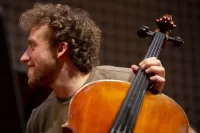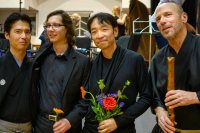
Images of war, displacement and peace from Eritrea and Ethiopia featured in exhibit
An exhibition of drawings and paintings encompassing themes of war and peace by artist and activist Betty LaDuke opens at the Bates College Chapel on Monday, Sept. 23. The exhibit runs through Nov. 15 and is open to the public free of charge. Call 207-786-8272 for more information.
The Bates display features work based on LaDuke’s annual travels to Eritrea and Ethiopia. A small nation in the Horn of Africa bordering the Red Sea, Eritrea fought a 30-year war of liberation against Ethiopia, its larger and more populous landlocked neighbor.
LaDuke arrived in Eritrea in 1994, just three years after the long struggle between the two countries concluded. “I was delighted to see the people’s expressions of exuberance during this period of peace and reconstruction,” she said. LaDuke also witnessed the eruption of a 1998 border skirmish that quickly escalated into a two-year war. “I never expected to visit a war zone,” she said, but during periods of relative calm between major confrontations, she traveled throughout the region with Eritrean artists, visiting war-torn villages, relocation centers and camps for displaced persons.
LaDuke returned home to Ashland, Ore., to begin a series of acrylic paintings that symbolized survival and endurance in the harsh conditions of war, refugee camps and endless waiting. While such experiences are common worldwide, says the Bronx-born artist, “this was the first time I witnessed these conditions and responded from an artist’s perspective. While Africa has been the catalyst for this exhibit, its themes and emotions are universal.”
An acclaimed printmaker and painter whose work focuses on multicultural issues, LaDuke has visited Asia, the South Pacific, Central and South America and Africa during the past 40 years. A member of the art faculty at Southern Oregon University, where she taught drawing and painting for more than 30 years, LaDuke has spent as many years advocating for social change, racial equality, the rights of women, children and the environment. Since 1986, her keen interest in the people and cultures of Africa has led her to portray the color, texture and rhythms that dominate African rural life.




